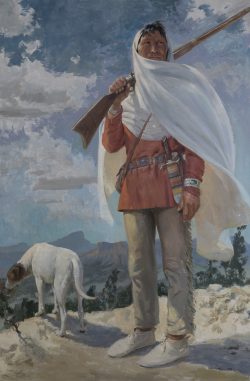Frederic Mizen 1888–1964
Frederic Kimball Mizen was born in Chicago and showed an aptitude for art at an early age. In 1904, as a teenager, he enrolled at the J. Francis Smith Academy in Chicago, where instructor Walter Ufer encouraged him to depict Southwestern subjects, then coming into great popularity. Mizen found work as a catalogue illustrator for Sears Roebuck and Company and attended evening classes at the Art Institute of Chicago. He soon became a highly successful illustrator, creating art for popular magazine covers, billboards, and promotional materials and counting the Santa Fe Railroad and Coca-Cola among his major patrons.
Mizen made numerous trips to the Southwest and became well known for his paintings of Native Americans and the landscapes of Arizona and New Mexico. He also established a thriving practice of portrait painting and was favored for official corporate portraits. An educator as well as a fine and commercial artist, Mizen opened his own art school, the Frederic Mizen Academy of Art, in Chicago in 1936; it is now remembered in part for revoking its offer of admission to young African American artist Charles White on the grounds of his race. Thanks to his artistic conservatism, Mizen found a favored position in Mrs. Frank Logan’s Society for Sanity in Art, which crusaded against modernism. He also exhibited with the Association of Chicago Painters and Sculptors, a conservative organization that broke away from the Chicago Society of Artists in 1922; with the Chicago Art Galleries, where he won the Municipal Art League Prize in 1951; and with the Artist Guild, an organization of commercial artists. A resident of suburban River Forest, he was active in the Austin, Oak Park, and River Forest Art League (now the Oak Park Art League).
In 1943, with enrollment declining due to wartime enlistment, Mizen closed his academy. Nine years later he was appointed head of the art department at Baylor University, in Waco, Texas, where he introduced commercial art studies, art education, and other practical subjects into the fine arts curriculum. In Texas and in Oklahoma he found important corporate commissions for both portraits and landscapes, as well as opportunities to show his work in local colleges, libraries, and women’s clubs. On his retirement in 1960, the artist opened a studio in Austin, Texas, moving the following year to Altadena, California. Mizen was painting a series of Indian scenes for the Santa Fe Railroad when he died there at the age of seventy-six.
Wendy Greenhouse, PhD
